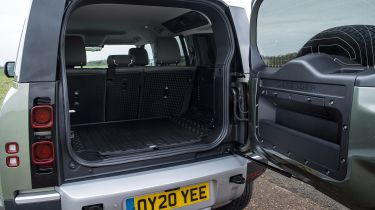Land Rover Defender review - Practicality & boot space
"Configured wisely, the Land Rover Defender offers serious load-lugging abilities"
Like the rest of the Defender's attributes, the practicality on offer is also highly flexible and customisable. The biggest decision facing buyers will be which version to go for; Land Rover offers the Defender in three lengths: the 90, 110 and 130.
Land Rover Defender interior space & storage
Choose the three-door 90 and the Defender can still carry up to six people. Or at least that was the case, until Land Rover dropped the small front jump seat from the options list. It's big enough for kids, and when the optional middle seat isn't in use, folding it forwards transforms it into a large central armrest and cubby.
The biggest sticking point for the Defender 90 is the lack of rear doors because anyone getting in the back has to climb rather high to negotiate the front seats. The boot isn’t very big on this version, either.
The 110 is also offered in a 5+2 layout, which is Land Rover speak for adding two smaller seats in the boot. These are best suited to kids but adults may also be able to travel for shorter hops in a pinch.
The 130 adds a further seat in that third row; an extra 340mm of length means there is more room, and the raised stadium-style seating gives a better view for those in the very back. We’d suggest these seats are probably best suited for two adults and a child, rather than a trio of fully-grown humans. From 2024, the Defender 130 can be optioned with a pair of swivelling captain’s chairs in the second row, replacing the three-seat bench. This reduces the total number of passengers from eight to seven, but makes it easier to climb into the third row of seating.
More reviews
The Defender also offers handy features like USB or 12-volt power sockets for charging portable devices, a backpack that secures to the rear seat and 'click and go' system for middle-row passengers to attach tablets, bags, laptops and jackets. Then there are innovations like the side mounted 'Gear Carriers' that are 24-litre lockable and waterproof containers that mount on the Defender's rear window pillars in a similar fashion to motorcycle saddle bags.
Boot space
As you’d expect, the longest Defender 130 will prove the most practical model in Land Rover’s lineup. Even with all three rows of seats in place there is 389 litres of boot space, which is more than you’ll find in a Volkswagen Golf. Fold down the second and third row and you’ve got a van-like 2,300 litres to play with. Cars without the rearmost seats bump this to a scarcely believable 2,516 litres.
And yet the middle-length Defender 110 is still a hugely practical car. This version has 231 litres of carrying capacity with the third row in place, or 2,233 litres with the second and third row folded flat. It’s worth noting that Land Rover measures these volumes slightly differently to other manufacturers, so they aren’t strictly comparable. Regardless, both the 130 and 110 should prove plenty practical enough for most families.
Space behind the seats drops slightly in the P400e model, which has a higher boot floor because of its battery pack but this isn’t a dealbreaker; the space is still a good size. A rubberised floor is designed to shrug off spills and be brushed or wiped clean. The Defender 90 is notably less spacious, with a shallow 397-litre boot that's on par with the bigger 130 with all eight seats in place, and smaller than a Honda Civic's all told.
One thing that may be of consequence if you regularly park on the street or in tight car parks, is the traditional side-hinged tailgate. This can be fairly heavy (it also carries a full-size spare wheel) and will require some room behind the vehicle to open fully. However, it does open on the correct side for UK roads, with the opening towards the kerb, and is a characterful nod towards its predecessor.
Towing
Defenders have long been used for towing, and the latest version is seriously capable. It can pull a 3,500kg braked trailer (3,000kg for the P400e and P300e), and the Defender itself has a maximum payload of 900kg. It can also accept a static load on its roof of up to 300kg.










